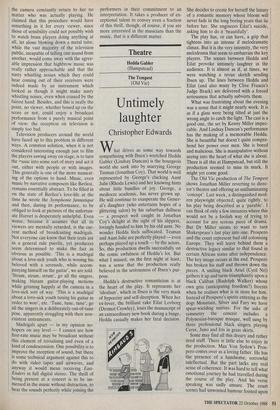Music
Better not look
Peter Phillips
0 ne of the reasons why I am dying not to own a television set is that the amount of classical music likely to be broadcast through it seems to be on the increase. I make this estimate on the evidence of the Prom series just finished, when the camer- as were there almost every night that I was, which was quite a few, and more than last year for both of us. Indeed the status of a concert depended, in the minds of my more experienced guests, on the number and positioning of the cameras. The most elaborate productions had two in the pit, two on stage, two raised up in the tiers overhanging the stage and one wrapped round Henry Wood's neck in the organ gallery. The meagrest detachment con- sisted of the two in the pit and one vagrant on stage. They never seemed to be in use for the whole concert, though the oper- ators of those downstairs, pleased to have a good seat, regularly stayed for the pieces they were not actually filming.
I could never get close enough to the cameras to see what was written on those note-pads that are strung up to one side of them, but I have been assured that some- one who knows the musical scores inside out plans every move and every angle in advance, and is able to communicate his requirements to his men by some sophisti- cated shorthand language. What with one thing and another, the extra bright lights, the white-jacketed back of the presenter high up in his box, the flicker of the TV monitors around the hall, one could have hoped for special insights into the music, if only by virtue of staring at it from close quarters.
Of course, this did not happen. One aspect of the art-apart nature of music is that it is entirely unsuitable for television, except at the superficial level of showing the performers at work. My tutor at Oxford, an estimable man who knows all there is to know about Berlioz, liked to maintain that the only hope for televising an orchestra was to invite a very attractive girl to play the piccolo or some such distinguishing instrument, and then have the camera constantly return to her no matter who was actually playing. He claimed that this procedure would have something in it for every viewer, since those of sensibility could not possibly wish to watch brass players doing anything at all, let alone blowing down a metal tube; while the vast majority of the television public, incapable of telling one sound from another, would come away with the agree- able impression that highbrow music was really rather approachable and that the nasty whistling noises which they could hear coming out of their receivers were indeed made by an instrument which looked as though it might make nasty whistling noises, even when coaxed by the fairest hand. Besides, and this is really the point, no viewer, whether boned up on the score or not, could enjoy a broadcast performance from a purely musical point of view: the reception on television is simply too bad.
Television producers around the world have faced up to this problem in different ways. A common solution, when it is not considered interesting enough just to film the players sawing away on stage, is to turn the –tusic into some sort of story and act it out, either with people or with images. This generally is one of the more nauseat- ing of the options to hand. Music, even music by narrative composers like Berlioz, remains essentially abstract. To be filled in on the state of Berlioz's love-life at the time he wrote the Symphonie fantastique and then, during its performance, to be obliged to look at pictures of the unfortun- ate Harriet is desperately unhelpful. Even worse, because it assumes that all its viewers are mentally retarded, is the cur- rent method of broadcasting madrigals. Not everyone can know that their texts are as a general rule puerile, yet producers seem determined to make the fact as obvious as possible. 'This is a madrigal about a love-sick youth who is wooing his beloved with a serenade, while accom- panying himself on the guitar', we are told. `Strum, strum, strum', go all the singers, making blatant guitar-playing motions while grinning happily at the camera in a love-sick sort of way. 'This is a madrigal about ,a love-sick youth tuning his guitar in order to woo', etc. 'Tune, tune, tune', go all the singers in a deliberately out-of-tune pose, apparently struggling with their non- existent instruments.
Madrigals apart — in my opinion no- hopers on any level — I cannot see how first-rate music may be broadcast without this element of trivialising and even of a kind of condescension. One possibility is to improve the reception of sound, but there is some technical argument against this to do with video tapes and airwaves, and anyway it would mean receiving East- Enders in full digital stereo. The thrill of being present at a concert is to be im- mersed in the music without distraction, to hear the sounds perfectly while joining the
performers in their commitment to an interpretation. It takes a producer of ex- ceptional talent to convey even a fraction of this thrill, though, of course, if you are more interested in the musicians than the music, that is a different matter.



































































 Previous page
Previous page